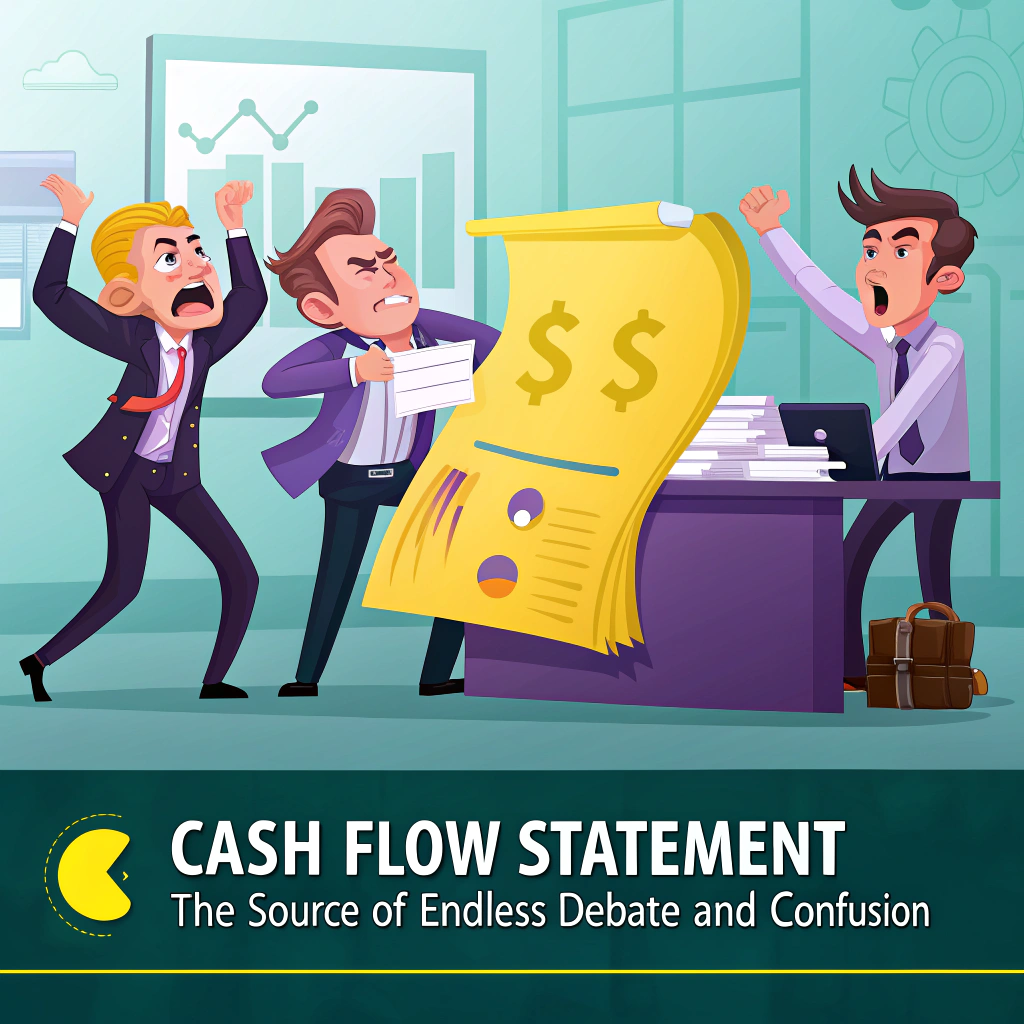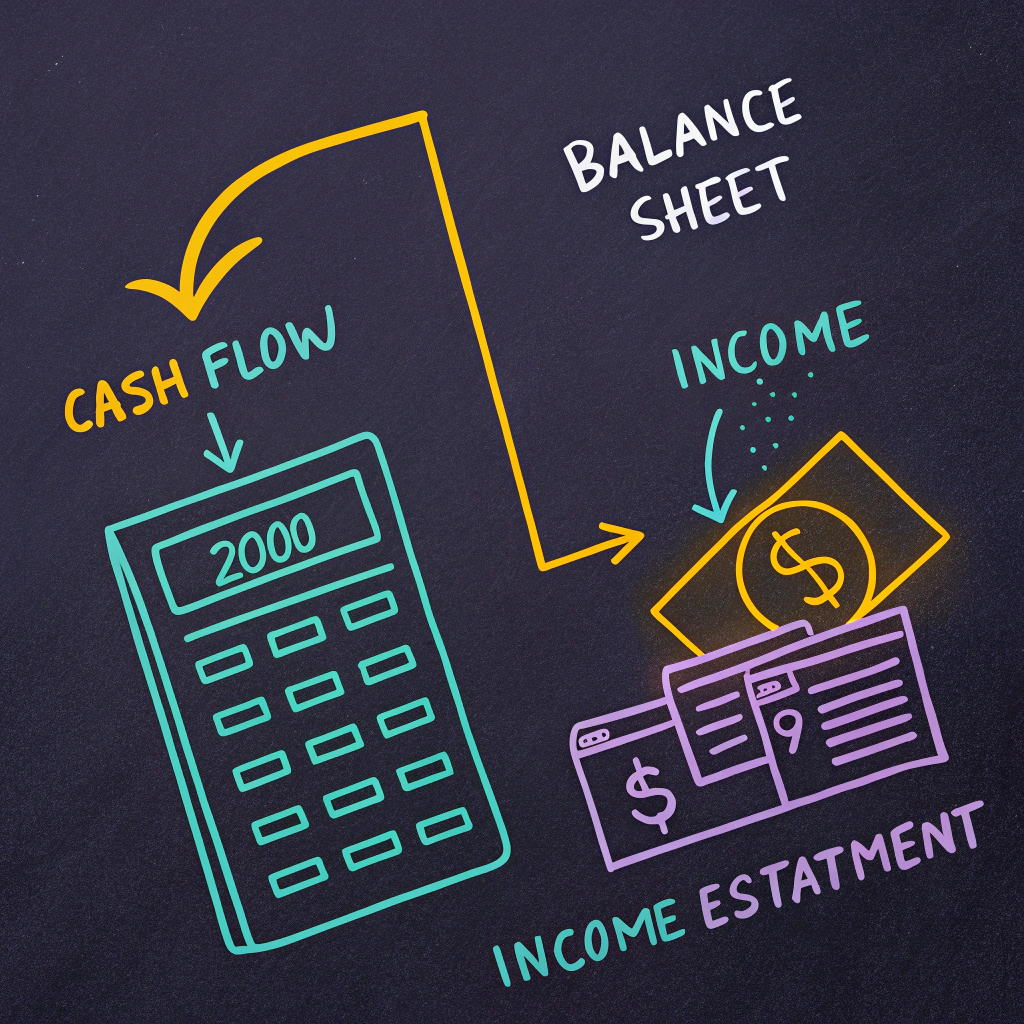Hey there, future financial wizards! Ever stared blankly at a cash flow statement, wondering if it’s written in ancient hieroglyphics? You’re not alone. But guess what? Today, we’re turning that mystifying document into your new best friend. We’re going to dive deep into how to build a cash flow statement from a balance sheet and an income statement using the indirect method. Stick with me, and by the end of this, you’ll be schooling those accountants—or at least keeping up at your next finance meeting without nodding off.
A cash flow statement is like the heartbeat monitor of your business. It shows the rhythm of cash coming in and going out, giving you a clear picture of your company’s liquidity and its ability to pay bills and make profits. Because let’s face it, profit without cash is like a car without gas—it looks good, but it’s not going anywhere.
Your balance sheet lays out what you own (assets) and what you owe (liabilities), plus the shareholders’ equity (the owner’s stake). The income statement, on the other hand, is the story of your revenues and expenses over a period. But how does cash actually move through your business? That’s where the cash flow statement steps in.
What Is a Cash Flow Statement?
Think of the cash flow statement as your company’s financial GPS. It tracks the routes your cash takes, pinpointing where it’s coming from and where it’s headed over a specific period. It’s divided into three main sections:
- Operating Activities: Cash flows from your core business operations—like selling products or services. This is the daily grind.
- Investing Activities: Cash used for or generated from investments in long-term assets, like buying or selling equipment. It’s all about the big moves.
- Financing Activities: Cash from or repaid to external sources like investors or creditors—think issuing shares or paying dividends. Basically, how you’re financing your venture.
Before we jump into building your own cash flow statement, let’s lay down some groundwork. Here are a few tips to keep you from pulling your hair out:
- Mind Your Signs (+/-): Positive numbers mean cash is flowing in (hooray!), while negative numbers mean cash is flowing out (still important, but less fun).
- Cash Is King: We’re only interested in actual cash movements. Non-cash transactions need not apply—they’re like the fake friends of finance.
- Adjust for Non-Cash Items: Depreciation, amortization, and other non-cash expenses affect your net income but not your cash flow. We’ll need to adjust for these sneaky entries.
We’ll dive into examples for each of these points. Ready to become a cash flow maestro? Let’s get started!
Important Points to Note When Building a Cash Flow Statement from Balance Sheet and Income Statement
- Pay close attention to positive and negative signs.
- Remember, we’re only interested in the movement of cash—cash inflows and outflows.
- Adjust for non-cash transactions that affected your net profit.
We’ll walk through examples and calculations for each point. Then, we’ll tackle a full example using a comparative balance sheet and an income statement to create a cash flow statement. Let’s make accounting fun (or at least less painful)!
Understanding the Importance of Cash and Cash Equivalents
Cash and cash equivalents are the lifeblood of your cash flow statement. They’re like the fuel in your business’s tank. Everything we’re going to calculate revolves around how these amounts change over the reporting period.
So, what’s a cash equivalent? It’s an asset that can be quickly converted into cash, typically within three months. Think short-term investments that are as good as cash.

What Are Examples of Cash Equivalents?
A solid example is money in your bank account. Other examples include short-term treasury bills and investments in shares of another company that you can sell off faster than you can say “liquidity.”
After you’ve prepared your cash flow statement, the net change in cash and cash equivalents should match the difference between the amounts from the previous period and the current period. If they don’t match up, it’s like discovering you’ve been wearing mismatched socks all day—something’s off.
In a nutshell, cash and cash equivalents help you verify that your cash flow statement is accurate. They’re your financial checks and balances.
Ready to crunch some numbers? Let’s calculate the net increase or decrease in cash and cash equivalents.
Example of How to Calculate the Net Increase or Decrease in Cash and Cash Equivalents:
Take a look at this snippet from a comparative balance sheet:
| Cash movement | 2019 | 2020 |
| Short-term Investments | 10 | 40 |
| Cash in Hand | 60 | 90 |
| Cash in the Bank | 40 | 30 |
Calculating the total cash and cash equivalents:
- For 2019: 10 (Short-term Investments) + 60 (Cash in Hand) + 40 (Cash in the Bank) = 110
- For 2020: 40 + 90 + 30 = 160
The net change is 160 – 110 = +50.
This means there’s a net increase of $50 in cash and cash equivalents from 2019 to 2020. If the number were negative, it would indicate a decrease—a signal that cash is flowing out. Remember to keep an eye on those signs; they’re the traffic signals of your cash flow statement.
One more example:
Here’s another excerpt from a comparative balance sheet:
| Current Assets | 2019 | 2020 |
| Short-term Investments | 10 | 40 |
| Cash in Hand | 40 | 30 |
| Cash in the Bank | 60 | – |
And under Current Liabilities:
| Current Liabilities | 2019 | 2020 |
| Trade Payables | – | – |
| Bank Overdraft | – | 10 |
Notice that we have a bank overdraft of $10 in 2020 under liabilities (yes, sometimes cash can be a liability). When calculating cash and cash equivalents, subtract any cash equivalents listed as liabilities from your assets.
So, your net cash and cash equivalents for 2020 would be:
- Total Cash Equivalents in Assets: 40 (Short-term Investments) + 30 (Cash in Hand) = 70
- Subtract Cash Equivalents in Liabilities: 10 (Bank Overdraft)
- Net Cash and Cash Equivalents: 70 – 10 = 60
If you do the same for 2019 and compare, you’ll find the net increase or decrease in cash and cash equivalents. Understanding this change is crucial before diving into the meat of the cash flow statement.
Building a Cash Flow Statement from Balance Sheet and Income Statement
Now that we’ve warmed up, let’s get down to business. We’ll be using the indirect method, which starts with net income and adjusts for changes in balance sheet accounts to calculate cash flow from operating activities.
Here’s what you’ll need:
- A copy of the company’s balance sheet from the previous and current periods (to see the changes).
- A copy of the company’s income statement for the current period.
- Any additional information (like details on non-cash transactions) that might affect cash flow.
With these in hand, you’re ready to build your cash flow statement from scratch. Let’s break it down into steps.

Steps on How to Prepare a Cash Flow Statement from Balance Sheet
- Find the Net Income or Net Profit from the Income Statement.
- Calculate Cash Flows from Operating Activities.
- Calculate Cash Flows from Investing Activities.
- Calculate Cash Flows from Financing Activities.
- Calculate the Net Change in Cash and Cash Equivalents
Find the Net Income or Net Profit from the Income Statement
Your net income is the starting point. It’s usually the last line on your income statement—hence the term “bottom line.” If you’re given the profit after tax, remember to add back any tax expenses to get the profit before tax, since taxes might not have been paid in cash during the period.
Calculate Cash Flows from Operating Activities.
- Adjust for Non-Cash Transactions
Time to weed out the non-cash items. These are expenses or revenues that impacted your net income but didn’t involve actual cash. Common culprits include:
- Depreciation and Amortization: Added back to net income.
- Losses on Sale of Assets: Added back, because no cash was lost.
- Gains on Sale of Assets: Subtracted, since the cash received will be shown in investing activities.
How to Make Adjustments for Non-Cash Transactions
Here’s the golden rule:
- If a non-cash expense reduced net income, add it back.
- If a non-cash gain increased net income, subtract it.
Example: Making Adjustments for Depreciation
Imagine you bought a machine for $600 with an estimated useful life of 10 years. Each year, you’d record a depreciation expense of $60 ($600/10). This depreciation reduces your net income but doesn’t affect cash. So, on your cash flow statement, you’ll add back the $60 to net income.
Adjusting for Profit or Loss on Sale of a Non-Current Asset
If you sold an asset and recorded a gain or loss on your income statement, you’ll need to adjust for that. For a gain on sale, subtract it from net income. For a loss on sale, add it back. The actual cash from the sale will be recorded in investing activities.
Calculate Changes in Working Capital
Working capital involves current assets and current liabilities (excluding cash and cash equivalents—we’ve already dealt with those). Changes in these accounts affect cash flow. Here’s how to handle them:
- Increase in Current Assets: Cash outflow
- Decrease in Current Assets: Cash inflow
- Increase in Current Liabilities: Cash inflow
- Decrease in Current Liabilities: Cash outflow
- Increase in Inventories: Cash outflow (substract)
- Decrease in Inventories: Cash inflow (add)
If your inventory increased from $40 to $60, you’ve spent $20 more on inventory—cash outflow. Subtract $20 from net income.
- Increase in Accounts Receivable: Cash outflow (substract)
- Decrease in Accounts Receivable: Cash inflow (add)
If accounts receivable decreased from $60 to $40, customers paid off $20—cash inflow. Add $20 to net income.
- Increase in Accounts Payable: Cash inflow (add)
- Decrease in Accounts Payable: Cash outflow (substract)
If accounts payable increased from $40 to $60, you’ve delayed paying $20 to suppliers—cash inflow. Add $20 to net income.
Calculate Cash Flows from Investing Activities
This section records cash used for or generated from investments in non-current assets.
- Purchase of Non-Current Assets: Cash outflow (negative).
- Sale of Non-Current Assets: Cash inflow (positive).
Record the actual cash spent or received—not gains or losses from the sale (we’ve already adjusted for those in operating activities).
Calculate Cash Flows from Financing Activities
This covers cash transactions that affect long-term liabilities and equity.
- Issuing Shares or Bonds: Cash inflow (positive).
- Repayment of Loans or Bonds: Cash outflow (negative).
- Payment of Dividends: Cash outflow (negative).
Add up all the financing activities to find the net cash from financing activities.
Calculate the Net Change in Cash and Cash Equivalents
Add the net cash from operating, investing, and financing activities. This total should equal the net increase or decrease in cash and cash equivalents you calculated earlier. If it doesn’t, it’s back to the drawing board.
Example and Calculation
Let’s put theory into practice. Below are the comparative balance sheet and income statement for ABC, along with additional information.

Income Statement
| REVENUE | 60,000 |
| Cost of Sales | -17,500 |
| GROSS PROFIT | 42,500 |
| General and Admin Expenses | -13,200 |
| Selling and Marketing Expenses | -18,000 |
| Depreciation and Amortization | -850 |
| OPERATING PROFIT | 10,450 |
| Interest Expense | -50 |
| Tax Expense | -750 |
| NET PROFIT | 9,650 |
Comparative Balance Sheet
| ACCOUNT | January 2023 | January 2022 |
| Cash | 17,000 | 13,895 |
| Accounts Receivable | 12,500 | 7,850 |
| Other Receivables | 550 | 500 |
| Prepaid Expenses | 1,000 | 500 |
| Property, Plant and Equipment | 4,000 | 3,750 |
| Intangible Assets | 1,300 | 1,500 |
| TOTAL ASSETS | 36,350 | 27,995 |
| Accounts Payable | 8,125 | 10,000 |
| Taxes Payable | 3,200 | 2,800 |
| Accrued Expenses | 75 | 50 |
| Deferred Revenue | 3,000 | 2,000 |
| Long-Term Loans | 1,200 | 1,100 |
| Capital Contributions | 1,050 | 1,000 |
| Retained Earnings | 19,700 | 11,045 |
| TOTAL LIABILITIES AND EQUITY | 36,350 | 27,995 |
Sale of Furniture:
- Original Cost: 20
- Accumulated Depreciation: 5
- Sale Price: 10
Purchase of Non-Current Asset:
- Computer Equipment: 910
Raising/Repaying Funds:
- Long-Term Debt Raised: 100
- Common Stock Issued: 50
- Dividends Paid: 1,000
Step 1: Find the Net Profit
From the income statement, the net profit is 9,650.
Step 2: Find Cash and Cash Equivalents
Beginning Cash Balance (from January 2022): 13,895
Ending Cash Balance (from January 2023): 17,000
Net Increase in Cash: 17,000 – 13,895 = 3,105
Step 3: Adjust forOperating Activities
Add back depreciation and amortization: 850
Calculate loss on sale of furniture:
- Carrying Value: 20 (Original Cost) – 5 (Accumulated Depreciation) = 15
- Sale Price: 10
- Loss: 15 – 10 = 5
Add back loss on sale: 5
Current Assets (excluding cash):
- Accounts Receivable + Other Receivables + Prepaid Expenses
- January 2023: 12,500 + 550 + 1,000 = 14,050
- January 2022: 7,850 + 500 + 500 = 8,850
- Change: 14,050-8,850 = 5,200 (Increase in Current Assets; cash outflow)
Current Liabilities:
- Accounts Payable + Taxes Payable + Accrued Expenses + Deferred Revenue
- January 2023: 8,125 + 3,200 + 75 + 3,000 = 14,400
- January 2022: 10,000 + 2,800 + 50 + 2,000 = 14,850
- Change: 14,400 – 14,850 = -450 (Decrease in Current Liabilities; cash outflow)
Step 4: Calculate Cash Flows from Investing Activities
- Purchase of Computer Equipment: -910
- Proceeds from Sale of Furniture: 10
Step 6: Calculate Cash Flows from Financing Activities
- Long-Term Debt Raised: 100
- Common Stock Issued: 50
- Dividends Paid: -1,000
Step 7: Compile the Cash Flow Statement
Net Cash from Operating Activities:
9,650 (Net Profit) + 850 (Depreciation) + 5 (Loss on Sale) – 5,200 (Decrease in Current Assets) – 450 (Increase in Current Liabilities) = 4,855
Net Cash from Investing Activities:
-910 (Purchase of Equipment) + 10 (Sale of Furniture) = -900
Net Cash from Financing Activities:
100 (Debt Raised) + 50 (Stock Issued) – 1,000 (Dividends Paid) = -850
Net Increase in Cash:
4,855 (Operating) – 900 (Investing) – 850 (Financing) = 3,105
Bingo!
Final Cash Flow Statement
With the correct adjustments, your net increase in cash should match the change in cash and cash equivalents from the balance sheet. If not, it’s time to revisit each step and find the error. Accuracy is key—after all, we’re dealing with your money here!
Congratulations! You’ve just built a cash flow statement from a balance sheet and an income statement. Who said accounting can’t be a bit adventurous?
